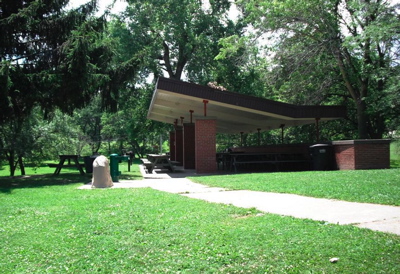Encyclopedia Dubuque
"Encyclopedia Dubuque is the online authority for all things Dubuque, written by the people who know the city best.”
Marshall Cohen—researcher and producer, CNN
Affiliated with the Local History Network of the State Historical Society of Iowa, and the Iowa Museum Association.
FLORA PARK
FLORA PARK. In an article of the Telegraph Herald, the City of Dubuque began making plans for what would become Flora Park in April, 1954. (1) The popular westside park was created through the generous donation of $100,000 by the WAHLERT FOUNDATION. (2) The gift allowed the city council to accept the offer of William L. MOLO to give the city the 7.5 acre plot called SILVER ACRES along with the 10.88 acres known as Sylvester Place. The latter parcel was appraised by a condemnation jury at $21,760. With the ten acres the city had already purchased, the recreation area included more than 28 acres of land.
The pool at the park created a great deal of interest. Opened on July 31, 1955 the pool was 75-feet wide and 198-feet long. (3) the pool was constructed using national competitive swimming standards and fit under the classification of a 60-meter pool--the kind used for AAU and NCAA competition. It was marked off in nine racing lanes. When asked, city officials suggested there was a good possibility it would be used for swimming competition. TENNIS COURTS were added to the park in 1956. (4)
In 1958 the Dubuque Junior Chamber of Commerce JAYCEES announced plans for the northern section of the park. A "modernistic playground" patterned after the Dennis the Menace Playground in Monterey, California was envisioned by Peter Joseph TAKOS. The first project chairman was Charles Ray, Jr. succeeded by Thomas Loosbrock. Work on a concrete tri-cycle path winding through the area began on September 13, 1958. Other attractions planned, of which some were never started, included a whale drinking fountain, a floating raft anchored in a one-foot deep pool, a spring gym, airplane, and balancing beam. What became known locally as the "rocket ship," was a structure built of steel reinforcing rods for climbing and supporting poles children could slide down. Each piece of play equipment was surrounded by concrete curbing holding in a bed of sand. Just before its grand opening on July 22, 1960 the playground received a 1918 fire engine once used by the JOHN DEERE DUBUQUE WORKS. (5)
In 1960 a gift of $30,000 by the Wahlert Foundation allowed the purchase of 26,345 square feet of land adjacent to Flora Park. The donation was used to purchase Ertl Company property near the end of Wilbricht Lane. The Ertl Company had moved its manufacturing operation to Dyersville in 1959. Immediate plans for the land and buildings had not been made at the time of the purchase although officials indicated they would be used for recreational of park purposes. (6)
Although dedicated on October 16, 1960, the playground continued to grow. In April 1961, "Randolph," a five-tentacled 'pentapus', sculpted with concrete over a rebar frame by students of Hector Garcia's CLARKE COLLEGE and designed by Joan DuBay, arrived. The five-feet tall and 18 feet wide gigantic-eyed creature was meant to be crawled over and through.
On June 15, 1967 the Dubuque Park Board decided to permanently close the southwest entrance to the park just below the crest of a hill on Pennsylvania. Located just east of Palm Court, the entrance/exit was considered too much of a traffic hazard. At the same time, a request of radio station WDBQ for an easement through the park was rejected. The decision was reached after discovery was made that the station had sold other property bordering the station's tower leaving it landlocked. (7)
Efforts to establish a youth center in the park in 1968 were rejected by the Dubuque Park Board. Youth for Dubuque, Inc., a three-member group headed by Buzz Bisanz, a freshman at LORAS COLLEGE asked the board for a small plot of ground for the construction of a steel Youth Center to be operated by the teenagers. The youth said they would raise the estimated $70,000 needed for construction. Nearby residents did not support the project. (8)
Relocated from the site of Hempstead High School to Flora Park, "The Barn" became the home of a successful theater company, the BARN COMMUNITY THEATER. Later this renovated building became the DUBUQUE MONTESSORI SCHOOL.
In March 1989 city voters approved borrowing $3.25 million to demolish and replace the old Municipal Pool and the Flora Park pool. In June 1991 the $1.7 million renovation to the Flora pool was expected to draw 80,000 swimmers during the summer. New attraction to the pool included two water slides, spray fountains, and sunbathing areas. (9)
The park was named by the Dubuque Park Department in memory of Wahlert's wife, Flora.
---
Source:
1. Day, Mike, "'Modernistic Playground,'" Telegraph Herald, April 30, 2024, p. 7A
2. Simplot, John. "Big Splash in Dubuque When New Pool Opens," Telegraph Herald, April 3, 1955
3. Day
4. Freund, Bob, "Plans Laid for Every Cent of Building Bonanza," Telegraph Herald, June 21, 1977, p. 5
5. Day
6. $30,000 Gift for Land Made By Wahlert Foundation," Telegraph Herald, May 18, 1960, p. 1
7. "Flora Park to Lose Its SW Entrance," Telegraph-Herald, June 15, 1967, p. 1
8. "Youths Denied Flora Park Site for a Center," Telegraph Herald, September 26, 1968, p. 19
9. Japson, Bruce. "Officials: 80,000 to Use Pool," Telegraph Herald, June 2, 1991, p. 3A


